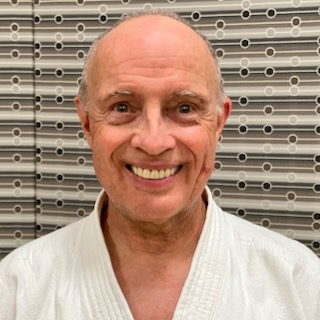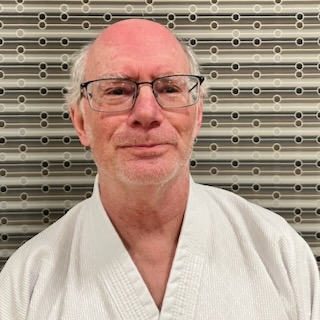Aikido is a non-competitive, martial art developed in Japan by Morihei Ueshiba in the early 20th century. Ueshiba adapted ancient samurai fighting styles (especially daito-ryu jiujitsu) to allow practitioners to protect themselves without harming others. Aikido emphasizes “blending”—rather than meeting force with force, Aikido practitioners learn to unbalance and throw or immobilize opponents by using attackers’ kinetic energy against them. Aikido is not a sport. Most Aikido practitioners do not compete in tournaments. Aikido is practices to realize our best selves, not to defeat others.
Aikido practitioners learn many things, including:
- Agility, flexibility, strength, confidence, and self-discipline
- Defences against various strikes and grabs
- Joint locks, throws, and pins
- Rolls, tumbles and somersaults (used to escape from throws, locks, and other precarious situations)
- Use of three weapons: sword, knife, and jo (a 4′ wooden staff)
- Defences against attacks with weapons
- Defences against multiple attackers
A Typical Class
An aikido class typically includes the following elements:
- Setting up the training space, including arranging training mats.
- “Bowing in”: Sitting in a line on the mats and bowing to show respect for the Aikido traditions and the instructor
- Warm-ups including calisthenics and stretches.
- Footwork, striking, rolling or tumbling exercises where an instructor demonstrates a movement and each student copies it.
- Paired katas (forms), in which an instructor demonstrates a technique (typically a joint lock or throw) and students practice the technique in pairs. Each student alternates between giving and receiving the technique. (It’s the receiving practice that makes aikido students so agile.)
- (sometimes) Solo or paired weapons practice.
- (sometimes) Randori (freestyle practice) where students face multiple attackers typically all attacking in the same prescribed manner.
- “Bowing out” and putting away training equipment.
There is no sparring. No one intentionally strikes anyone in an Aikido class, and practitioners adjust intensity based on each other’s preferences and skill level. Aikido dojos use special mats that absorb impact when falling or rolling. Some aikido techniques can be uncomfortable but everyone decides for themselves how much discomfort they want to tolerate.
Our Dojo
Halifax Aikikai is an Aikido dojo, founded in 1976, following the Aikikai style. Halifax Aikikai is a provincially registered, not-for-profit organization run for the benefit of its membership and for the training of Aikido. All funds from dues paid go towards the payment of rent, dojo expenses, and general upkeep of dojo equipment. All instructors are volunteers.
Located centrally in peninsular Halifax, we are affiliated with the Canadian Aikido Federation, and the Hombu Dojo, Aikido World Headquarters, in Tokyo, Japan. Our curriculum is set by the CAF, under the technical oversight of Hayato Osawa Shihan, 8th Dan.
Our Instructors
Thomas Hackmann, Chief Instructor, 5th Dan

Hackman Sensei took up Aikido at the age of sixteen. From age 18 to 24 he undertook intensive training at Asai Sensei’s dojo in Düsseldorf, Germany and was awarded the rank of Shodan in 1981. While in Germany he attended a number of seminars and summer camps and had the opportunity to meet other well known Japanese teachers (Noro Sensei, Kobayashi Sensei, Yamaguchi Sensei to name a few). In 1985 he moved to Vancouver, BC and trained under Kawahara Sensei from 1985 – 1990.
He arrived in Halifax in 1991 and assumed the role of Chief Instructor of Halifax Aikikai in 1998. He regards the study of aikido a lifelong path keeping in mind Ueshiba Sensei’s parting words to one of his students: “‘Intellectual training, physical training, virtue training, ki training – these produce practical wisdom.’ He added that it wouldn’t do for even one of these to be missing, that lacking any one of them would render everything for naught and inevitably slow one’s overall development. One must, he told me, always maintain a harmonious balance among these.” (Interview with Mariye Takahashi, Aikido Journal #120).
David Humphreys, Instructor, 5th Dan

Peter McAuley, Instructor, 3rd Dan

Peter started Aikido at the age of forty-three, in 2001, at Halifax Aikikai. With continuous and constant practice he was awarded his Shodan seven years later, and obtained his Nidan three years after that, proving that it is never too late to start your aikido training. In addition to great teachers locally, Peter has been lucky enough to train under Kawahara Sensei and Osawa Sensei, as well as other superb teachers from across the continent.
Katharina Kieser, Instructor, 2nd Dan
Katharina was drawn to Aikido as a martial art because of its nature of blending with an attacker’s energy. She started aikido in 1999 at Halifax Aikikai and has also trained in Toronto under Yumi Nakamura Sensei. Aikido has provided an art with continuous learning about people and their energy and how to blend together as uke with nage without clashing. To Katharina, these principles translate to life outside the dojo. She enjoys teaching and learning from all the aikidosa she encounters.
Edward Edelstein, Instructor, 2nd Dan

Edward began studying Aikido with Robert Nadeau in 1972 while attending the University of California at Berkeley. He has continued to practice mainly in Toronto and Halifax. He has been a guest practitioner in dojos across Canada and the US, and as far away as Oahu, Hawaii and Novosibirsk, Siberia. Edward has a master’s degree and years of experience in Waldorf Education. As a teacher, he enjoys focusing on teaching good fundamentals of this art.
